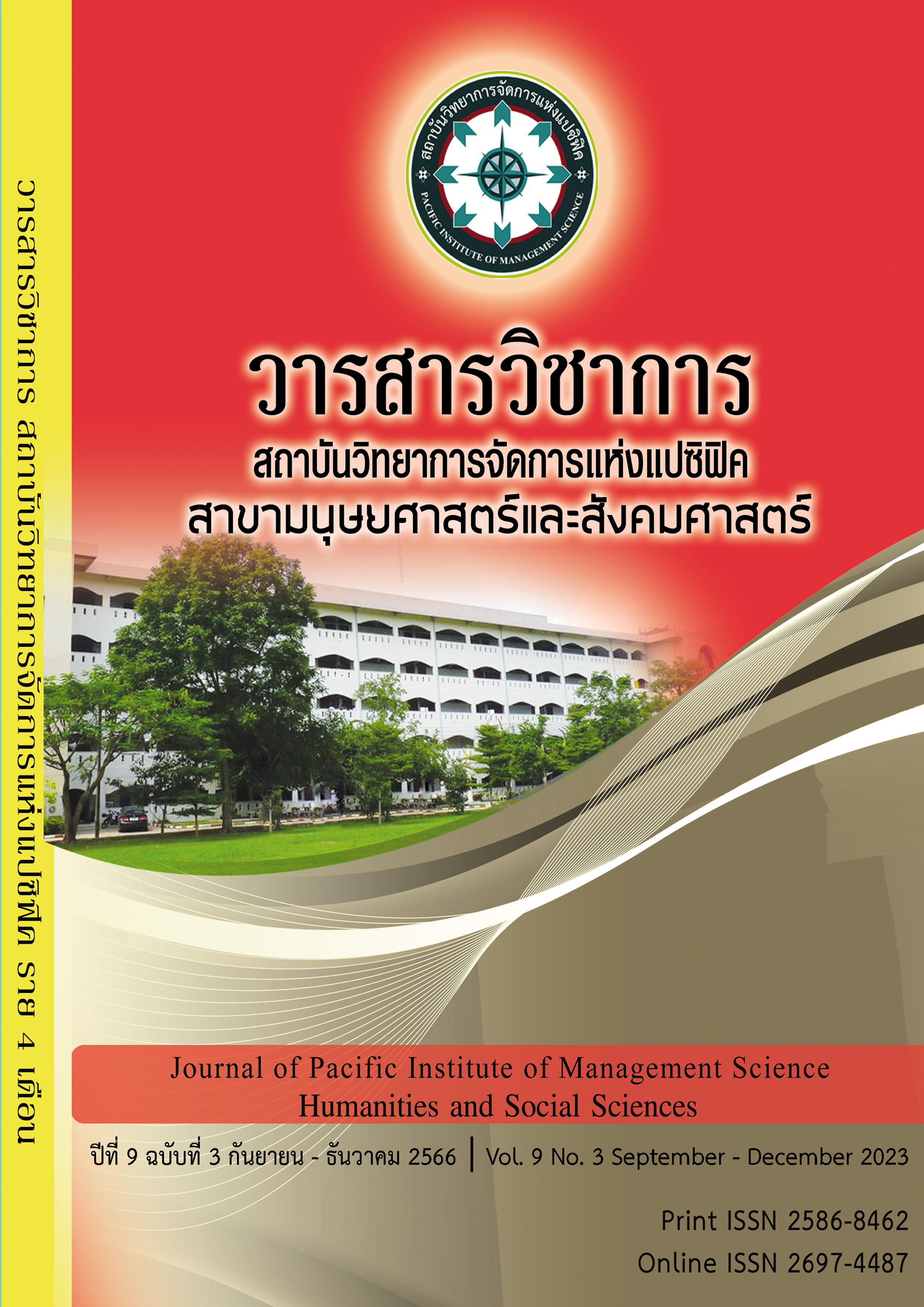The Design of English-Thai Alphabetical Flashcards with Augmented Reality Technology for Early Elementary School 1 - 3 Students
Keywords:
flashcards, English alphabets, augmented realityAbstract
This research aims (1) to develop enhanced English-Thai alphabetical flashcards with augmented reality technology with the E1/E2 = 85/ 85 criterion, (2) to compare the pre-test and post-test scores after learning with the flashcards, and (3) to evaluate the students’ satisfaction towards the flashcards. The research instruments used are (1) the enhanced English-Thai alphabetical flashcards with augmented reality technology, (2) the pre-test and post-test, and 3) a questionnaire on students’ satisfaction towards the flashcards. The samples are 60 students, whose phonics midterm-test scores are below 60 percent, selected via a purposive sampling method. The results of the study revealed that (1) the enhanced English-Thai alphabetical flashcards with augmented reality technology for early elementary school 1 - 3 students has the efficiency level of 85.14/85.06, which meets the set criterion. (2) The post-test mean score after learning with the flashcards is significantly higher than the pre-test mean score at the .05 level. And (3) The students are highly satisfied with the enhanced English-Thai alphabetical flashcards with augmented reality technology at 4.54 scores.
References
กระทรวงศึกษาธิการ. (2551). หลักสูตรแกนกลางการศึกษาขั้นพื้นฐาน พุทธศักราช 2551. [ออนไลน์]. สืบค้นเมื่อ 10 กันยายน 2562. จากhttp://www.thaischool.in.th/_files/thaischool/01.pdf
กัลยาณี ภู่เจริญ. (มปป). การสอนภาษาอังกฤษในศตวรรษที่ 21: จากอดีตถึงปัจจุบัน. [ออนไลน์]. สืบค้นเมื่อ วันที่ 10 กันยายน 2562. จาก http://www.academia.edu/38659595/การสอนภาษาอังกฤษในศตวรรษที่_21_จากอดีตถึงปัจจุบัน
ชัยยงค์ พรหมวงศ์. (2556). การทดสอบประสิทธิภาพสื่อหรือชุดการสอน. วารสารศิลปกรศึกษาศาสตร์วิจัย 5 (1) : 5–20.
นารีนารถ ห่อไธสง. (2555). การใช้ภาพยนตร์เพื่อพัฒนาทักษะภาษาอังกฤษ : การวิจัยปฏิบัติการรูปแบบวงจรลำดับเวลาของเจมส์ แมคเคอร์แนน (James Mckernan). การวัดผลการศึกษา 17 (1) : 187-199.
ปรียานุช ทองเกลี้ยง. (2562). ผลการใช้แบบฝึกประกอบภาพยนต์ที่มีต่อทักษะการฟังภาษาอังกฤษของนักเรียนระดับชั้นมัธยมศึกษาปีที่ 3. วิทยานิพนธ์ปริญญามหาบัณฑิต สาขาวิชาการสอนภาษาอังกฤษ มหาวิทยาลัยศิลปากร.
Armbruster, B., Lehr, F., & Osborn, J. (2006). Put reading first: The research building blocks for teaching children to read. Washington, DC: Partnership.
British Council. (2020). อุปสรรคเรียนรู้ภาษาเด็กไทยต้องแก้ตั้งแต่สอนจนถึงสอบ. [ออนไลน์]. สืบค้นเมื่อ วันที่ 7 มีนาคม 2563. จาก https://www.britishcouncil.or.th/about/press/4-อุปสรรคเรียนรู้ภาษาเด็กไทยต้องแก้ตั้งแต่-สอนจนถึงสอบ.
Byrne, B. and FieldingBarnsley, R. (1989). Phonemic awareness and letter knowledge in the child's acquisitions of the alphabetic principle. Journal of Educational Psychology 80 (1) : 313-321.
Davis, D., & Berland, M. (2013). Supporting English learners with participatory augmented reality simulations. On the Horizon 21 (4) : 294-303.
DeCoux, V. M. (2016). Kolb's learning style inventory: A review of its applications in nursing research. Journal of Nursing Education 29 (5) : 202-207.
Dung, N.T. (2015). Literature review and critical reflection on learning styles and strategies of “ Asian learners”. Journal of Science, An Giang University 1 (1) : 116-124.
Fukushima, SH. (2019). Design of Enhanced Flashcards for Second Language Vocabulary Learning with Emotional Binaural Narration. Proceedings of the 10th Augmented Human International Conference March 11-12 : 1-2.
Hatami, S. (2015). Second Language Incidental Vocabulary Acquisition through Reading and Listening. Doctoral dissertation University of Alberta.
Johnson, J. L., Khan, A. A., & Saeed, K. (2020). Learning Styles Inventory and Experiential Learning Theories: An Integrative Review of Literature. Pakistan Journal of Society, Education and Language (PJSEL) 6 (1) : 1-12.
Kaushik, P. (2017). Redefining Learning: Kolb's Theory of Learning Styles with Gardner's Multiple Intelligences. International Journal of Learning and Teaching 9 (1) : 330-339.
Kieffer, M. J., & Lesaux, N. K. (2007). Breaking down words to build meaning: Morphology, vocabulary, and reading comprehension in the urban classroom. The reading teacher 61 (2) : 134-144.
Krashen, S.D., & Terrell, T.D. (1995). The Natural Approach. London: Almany.
Li, J. T., & Tong, F. (2019). Multimedia-assisted self-learning materials: the benefits of E-flashcards for vocabulary learning in Chinese as a foreign language. Reading and Writing 32 (5) : 1175-1195.
Rath, L.K., & Kennedy, L. (2004). The Between the Lion Book for Parents. New York: Harper Collins.
Shin, S. C. (2020). Korean Language Learning in Socio-Educational Settings in Sydney: Motivation, Learning-Styles and Learning Experiences. 한국문법교육학회 학술발표논문집, 2020 (58) : 351-381.
Tang, T. Y., Xu, J. & Winoto, P. (2019). Automatic Object Recognition in a Light-Weight Augmented Reality-based Vocabulary Learning Application for Children with Autism. Proceedings of the 2019 3rd International Conference on Innovation in Artificial Intelligence March 15-18 : 65-68.
Trusty, A. & Truong, K. N. (2011). Augmenting the Web for Second Language Vocabulary Learning. CHI 2011. Session: Books & Language May 7-12 : 3179-3188.
Wilcoxon, F. (1945). Individual Comparisons by Ranking Methods. [Online]. Retrieved February 1, 2021. from http:// www.jstor.org/stable/3001968.
Yildiz, E. P. (2021). Augmented Reality Research and Applications in Education. [Online] Retrieved February 1, 2021. from https://www.intechopen.com/chapters/78230.
Zhu, Y., et al. (2017). ViVo: Video-Augmented Dictionary for Vocabulary Learning. Proceedings of the 2017 CHI Conference on Human Factors in Computing Systems May 06-11 : 5568-5579.
Downloads
Published
Issue
Section
License
Copyright (c) 2023 Pacific Institute of Management Science

This work is licensed under a Creative Commons Attribution-NonCommercial-NoDerivatives 4.0 International License.
บทความที่ได้รับการตีพิมพ์เป็นลิขสิทธิ์ของ สถาบันวิทยาการจัดการแห่งแปซิฟิค
ข้อความที่ปรากฏในบทความแต่ละเรื่องในวารสารวิชาการเล่มนี้เป็นความคิดเห็นส่วนตัวของผู้เขียนแต่ละท่านไม่เกี่ยวข้องกับสถาบันวิทยาการจัดการแห่งแปซิฟิค และคณาจารย์ท่านอื่นๆในสถาบันฯ แต่อย่างใด ความรับผิดชอบองค์ประกอบทั้งหมดของบทความแต่ละเรื่องเป็นของผู้เขียนแต่ละท่าน หากมีความผิดพลาดใดๆ ผู้เขียนแต่ละท่านจะรับผิดชอบบทความของตนเองแต่ผู้เดียว







